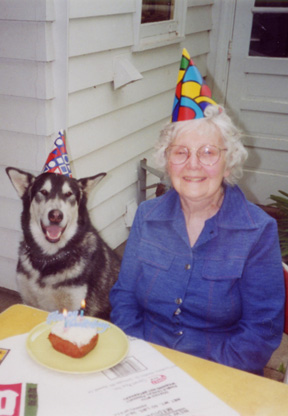The following information (except for the photo of Cain and Bessie) is copied verbatim from "Your Purebred Puppy, A Buyer's Guide" by Michele Lowell -- an excellent, invaluable book with information on over 160 dog breeds.

Alaskan Malamute
For Experienced Owners Only
Good with Older, Considerate Children
Large in Size
Thick, Medium-Length Coat
EXERCISE REQUIRED
TRIMMING/CLIPPING REQUIRED
AMOUNT OF SHEDDING
ACITIVITY INDOORS
EASE OF TRAINING
SOCIABILITY WITH STRANGERS
High Med Low
8=8
8=8
8=8
8=8
8=8
8=8
Temperament
Some remain playful puppies all their lives, others mature into calm, dignified adults. He likes the cold outdoors and belongs in the suburbs or country. He can be boisterous and needs a good amount of daily exercise. Too much confinement or isolation makes him restless and destructive -- some females will dig den holes in the sofa. Most are very friendly with strangers, but a few are reserved, and this is a big breed, so he should be accustomed to people at an early age. He can be aggressive with other dogs; he should be watched around small pets like cats and rabbits, and must be supervised outdoors, for he is an explorer who could run deer and molest livestock. Powerful and independent, he needs much firm obedience training (especially the commands heel, down, and come). Male Malamutes can be very dominant, and unless neutered and well-trained, may refuse commands from family members who have not established leadership over them. He howls a lot and can relandscape your yard with his digging. When well-trained, exercised, and supervised, this breed makes an impressive companion.
History
His name comes from the Mahlemut tribe, who used him to pull sledges. Today he is a pack dog, freight dog, and companion. He's not built for speed, so he's not a racer, but champion weight-pullers pull over 1000 pounds. AKC popularity: 40th of 130 breeds.
Physical Features
1.
2.
3.
4.
He stands 23-25 inches and weighs 75-110 pounds.
His coat is 1-2 inches long and coarse, with a dense undercoat, and should be brushed twice a week -- daily when he's shedding. He should be black, Alaskan seal (black with a creamy undercoat), sable (black with a red undercoat), wolf gray (gray with a gray/creamy undercoat), silver (light gray with a white undercoat), or red; he has white markings on his face, neck, chest, and legs. Rarely, he is solid white.
His ears prick up. His eyes are brown, but may be lighter in red dogs. His nose is black, but may be flesh colored on red dogs. His teeth meet in a scissors bite. His tail is carried over his back like a waving plume.
Disqualifications: His eyes should not be blue. (Identification note: the Siberian Husky can have blue eyes.)
Health Problems
He is susceptible to hip dysplasia, zinc deficiency skin disorders, thyroid problems, and achondrodysplasia (akondro-dis-PLAY-zhia), a congenital dwarfism where a puppy is born with a normal head and body but short, warped legs. With his thick coat, he doesn't like the heat. Buy only from OFA-registered and ChD- (achondrodysplasia) cleared parents.
Cautions when Buying
BE CAREFUL. This is a powerful, independent breed, and if you buy from a poor breeder or raise the dog incorrectly, you could end up with a dominant boss-dog Malamute. Don't choose the boldest, most energetic, or most independent Malamute puppy.
